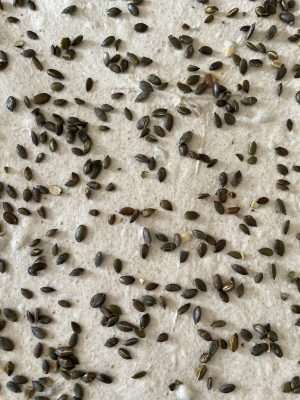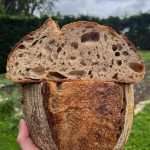Pumpkin Seed Sourdough
Packed full of pumpkin seeds & speckled with pieces of dried fig, this sourdough loaf is super nutty & crunchy. Great eaten at lunch or toasted at breakfast.
Equipment
- Large Glass Mixing Bowl
- Digital Food Probe
- Digital Scales
- Laser Temperate Gun
- Plastic Dough Scraper
- Metal Dough Knife
- Oval Banneton
- Baker's Lame
- Dutch Oven/Oval Casserole Dish (With Lid)
- Spray Bottle
- Wire Cooling Rack
Ingredients
To Feed The Starter.
- 50 g Strong White Bread Flour
- 50 g Strong Wholemeal Flour
- 100 g Water @78°f / 25.5°c
- 100 g Ripe Sourdough Starter
The Dough.
- 350 g Strong White Bread Flour 70%
- 100 g Strong Wholemeal Flour 20%
- 50 g Fig, Spelt & Pumpkin Seed Flour (See Notes) (10%)
- 375 g Water @78°f / 25.5°c 75%
- 1 tbsp Olive Oil
- 75 g Sourdough Starter - At Its’ Peak 15%
- 11 g Maldon Sea Salt 2%
- 50 g Pumpkin Seeds 10%
- Rice Flour - To Dust Banneton
Instructions
- Start by feeding your starter then leave at room temperature until it is at its’ peak, just before it starts to fall. This should take around 5 hours.
- In the meantime, toast the pumpkin seeds until golden brown. Either in a dry pan set over a medium heat or on a baking tray in a 180°c/160°c fan oven. Once cooked, set aside to cool completely.
- An hour before your starter is ready, place all three flours, 300g of the water & the tablespoon of olive oil into the bowl of a stand mixer. Using the dough hook, mix together until just combined. Cover & leave for an hour.
- Next, add the ripe starter into the dough & mix on a medium speed until combined. Cover & leave for another hour.
- Add in the salt & remaining 50g of water into the dough. Using your hands, squeeze the salt & water into the dough then transfer to a clean work surface.”Slap & Fold” the dough until it comes together & is less sticky, roughly 5-10 minutes.Transfer the dough to a large, lightly oiled bowl (a clear glass one is best) & cover.
- Coil fold the dough enough times for it to pass the windowpane test - I’ve found the average amount of coil folds to be 6. In this recipe, the third coil fold is replace by lamination, which is when the pumpkin seeds are incorporated.To Laminate.Gently transfer your dough to a large work surface that has been lightly sprayed with water.Spread your dough gently & evenly from all sides to form a large rectangle. This should be as thin as possible.Scatter the toasted pumpkin seeds all over the top of the dough.Fold one side of the dough into the middle. Pressing down lightly on the dough between folds help to prevent large air pockets.Next, fold the opposite side over the folded side.Now take one of the remaining sides & fold it into the middle.Finally, take the last side & fold it over the side you just folded.Gently place the dough back into the bowl.The bulk ferment starts as soon as the starter is added to the dough & will take anywhere from 4-10 hours (depending on room temperature, dough hydration & flour used). When the dough has finished fermenting, it will have increased in volume by roughly 20-30%, the top will be domed & you will see lots of tiny bubbles in the dough.

- Once the bulk ferment has finished, gently tip the dough out onto a clean work surface, with the help of a dough scraper.
- Using a metal bench knife & a hand dipped in water, gently work the dough into a round shape. (Don’t shape it too tightly as this could damage the gluten in the dough.) Dust the top of the dough with rice flour & leave to rest for 20 minutes.
- Lightly dust a banneton with rice flour.Using a bench knife, gently loosen the dough from the work surface then carefully flip the dough over.Pull the bottom side of the dough up & fold it into the middle. Press down lightly to make sure the dough has stuck (press down lightly with every fold).Now take the left side, stretch it slightly & fold it roughly ¾ to the right.Next, stretch the right side slightly & fold over the left side.Take the top side, stretch it away from you then fold it into the centre of the dough.Now “stitch” the sourdough. Starting at the top, pinch a small amount of dough from both the left & right sides. Fold the dough from the right side over the centre, followed by the left side. Repeat this process in the middle section of dough then the bottom section. (Imagine the pattern of a laced up shoe).Finally, starting from the bottom to the top, carefully roll the dough over itself. Use a bench knife to gently pull the shaped dough towards you, dragging the bottom of the dough on the work surface. This seals the underneath & helps create tension.Dust the surface of the dough with rice flour, turn the dough upside down (so that the dough is seam side up) & place into the banneton.
- Cover the top of the banneton with clingfilm & place into a fridge for 12-15 hours. The longer the dough is left in the fridge, the more sour the final loaf will be.
- Place your casserole dish or Dutch oven into your oven & preheat to 230°c/210°c fan for 1 hour.The casserole dish I use can be used upside down so that the dough sits on the lid & the casserole dish itself acts as a lid. This means there’s plenty of room for oven spring.Whilst your oven is preheating, place the banneton with the dough in into a freezer.
- Remove the banneton from the freezer. Place your prepared piece of parchment over the top of the banneton then a chopping board/flat tray. Flip the banneton/chopping board over so that the dough is now sat seam side down on the parchment.To score the dough, hold the lame so that the razor is at an angle to the dough. Between 30° & 45°. Starting at the top end of the dough, slash the dough all the way to the bottom end. The score should be off centre to the right & at least 1cm deep. For best results, try to score in one cut. Dipping the razor in water before scoring helps produce a clean cut.Using the parchment, slide the dough into the preheated casserole dish. Spray generously with cold water & place the lid on the dish.
- Bake in the preheated oven, covered for 25 minutes then remove the lid & bake for a further 20-25 minutes, until the loaf is a deep, brown colour. For the best flavour, the dough should be fairly dark but not burnt.
- Transfer the dough to a wire rack & leave to cool completely before slicing. This will take a couple of hours.
Notes
Cooking In An Aga.
Toast the pumpkin seeds on the bottom set of runners in the baking oven.
Place your dutch oven/ casserole dish onto the grid shelf which is on the floor of the roasting oven. The flours I used are all from Shipton Mill. I’ve found that I get the best results using these but feel free to use whatever brand you prefer. The white & wholemeal flours are both Canadian blends.
If you can’t get hold of a spelt, fig & pumpkin seed blend make one using 25g wholemeal flour, 25g spelt flour & 10-20g of dried fig pieces. This dough has a slightly higher hydration level which allows for moisture absorption by the seeds. For detailed instructions on the methods & techniques used in this recipe, take a look at my step by step sourdough recipe. For best results, I’d recommend using either an oval casserole dish or a dutch oven to bake the bread in. I use a Samuel Groves oval casserole dish turned upside down (the bread sits inside the lid & the casserole dish acts as the lid.
Toast the pumpkin seeds on the bottom set of runners in the baking oven.
Place your dutch oven/ casserole dish onto the grid shelf which is on the floor of the roasting oven. The flours I used are all from Shipton Mill. I’ve found that I get the best results using these but feel free to use whatever brand you prefer. The white & wholemeal flours are both Canadian blends.
If you can’t get hold of a spelt, fig & pumpkin seed blend make one using 25g wholemeal flour, 25g spelt flour & 10-20g of dried fig pieces. This dough has a slightly higher hydration level which allows for moisture absorption by the seeds. For detailed instructions on the methods & techniques used in this recipe, take a look at my step by step sourdough recipe. For best results, I’d recommend using either an oval casserole dish or a dutch oven to bake the bread in. I use a Samuel Groves oval casserole dish turned upside down (the bread sits inside the lid & the casserole dish acts as the lid.
